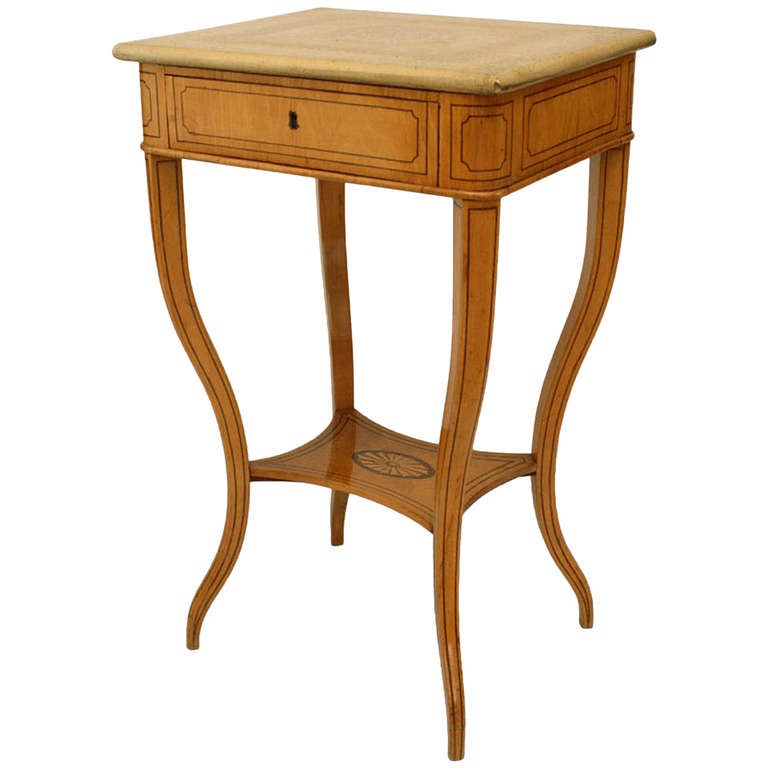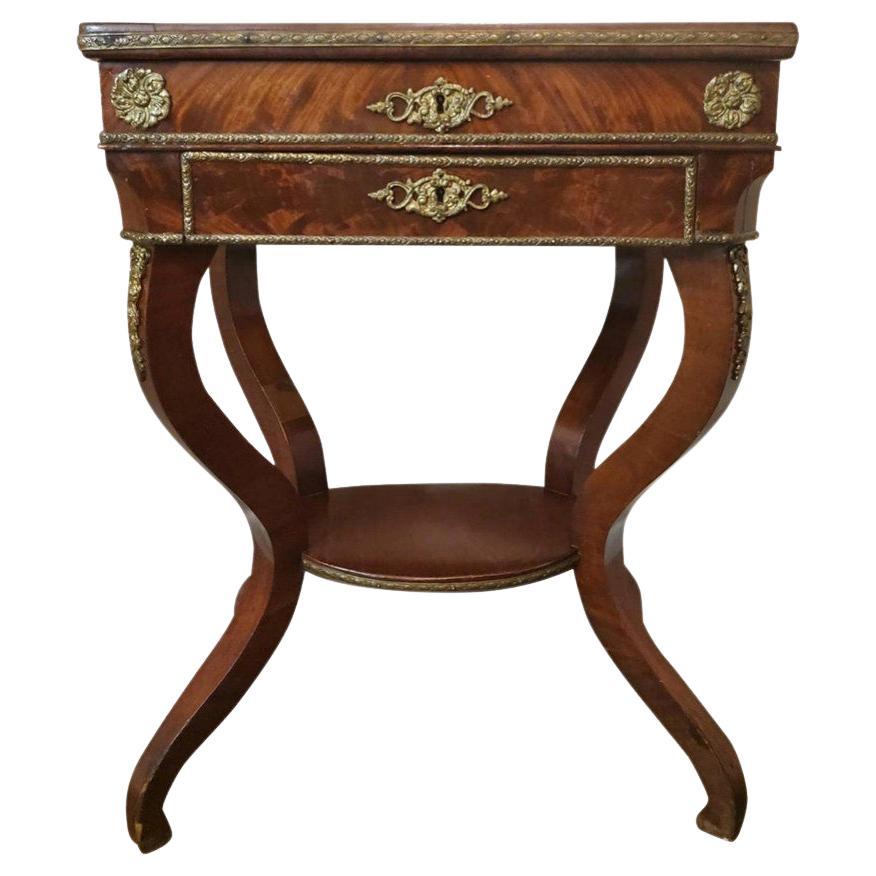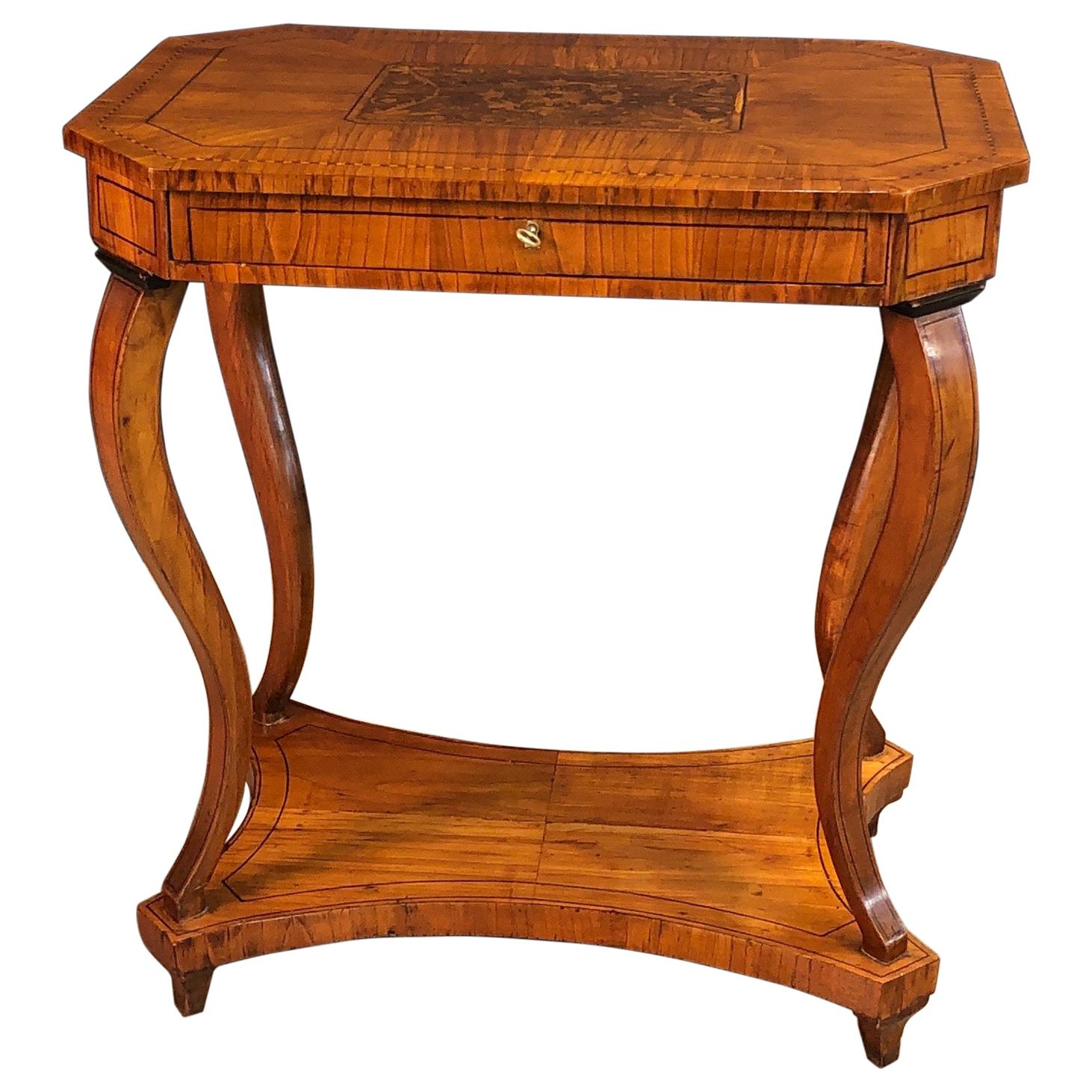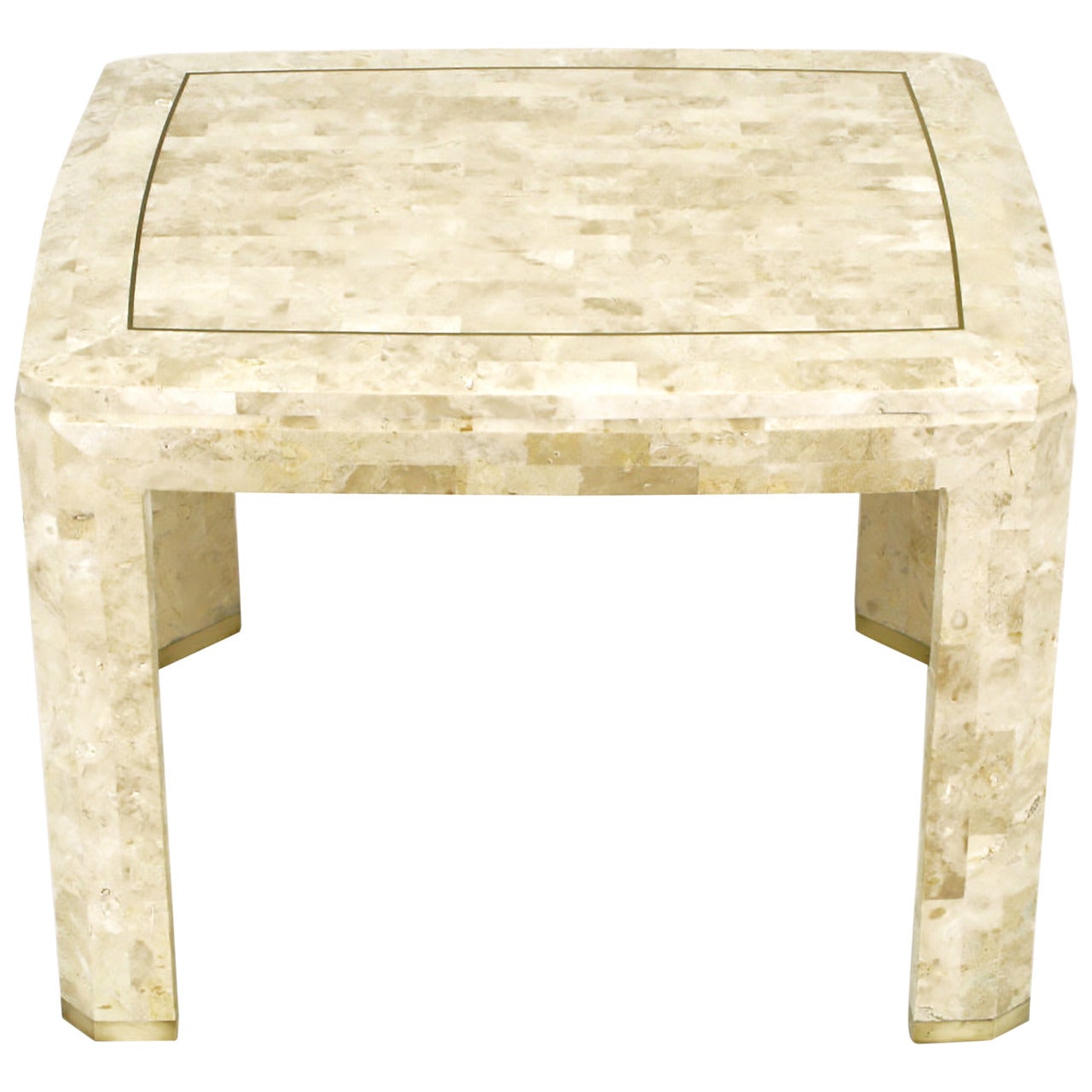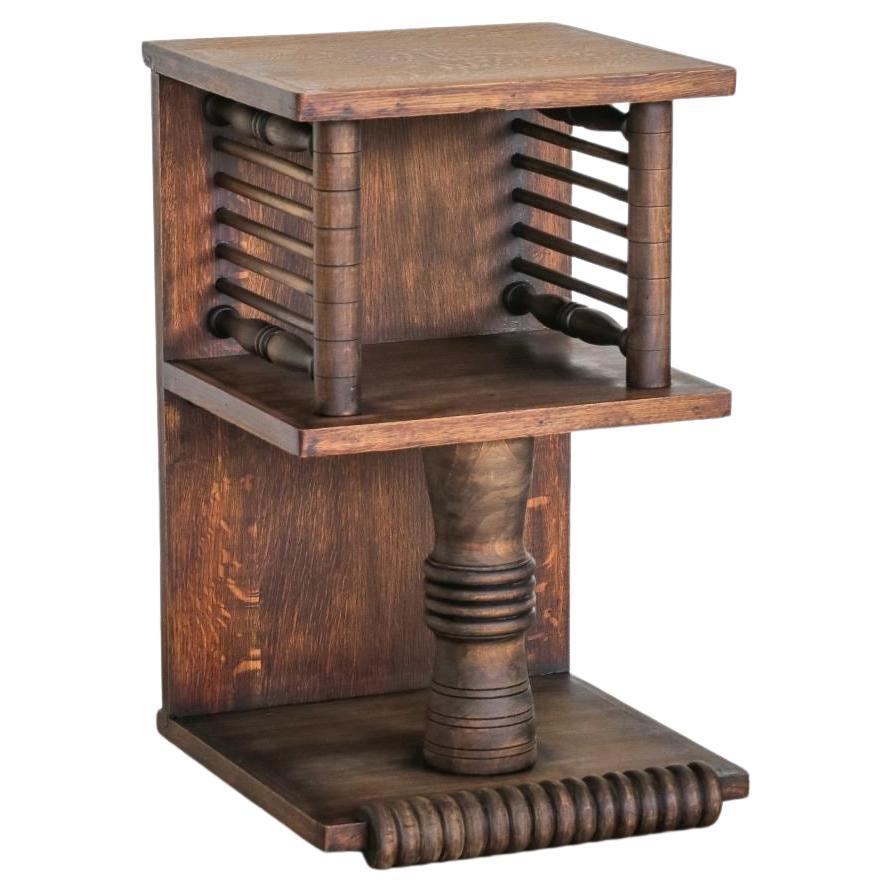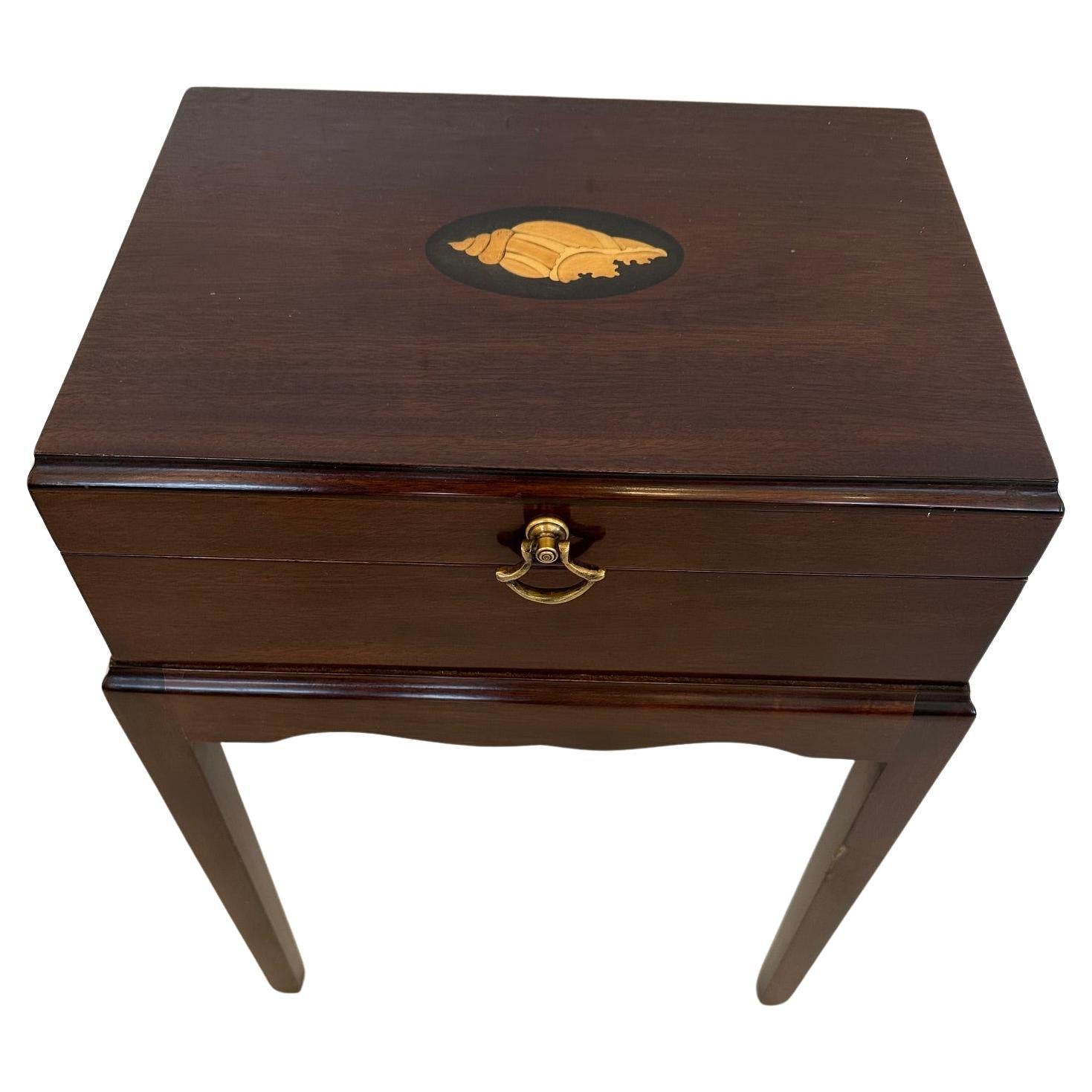Items Similar to French Charles X End table Sewing Box, wood and inlaid brass
Video Loading
Want more images or videos?
Request additional images or videos from the seller
1 of 22
French Charles X End table Sewing Box, wood and inlaid brass
About the Item
Gorgeous and very refined and elegant Charles X sewing box and leaf shaped table , around 1830 France. This small side table is made of mahogany wood and gold brass threaded inlays. It is structured in a simple and light way, the main body has an oval shape with very marked corners, which provides great refinement. It rests on four curved saber legs, which become thinner as they get closer to the ground. At the bottom, a kind of shell or piètements, characteristic of the auxiliary tables of the Charles X style. In addition to being a reinforcing element, it is also a lower shelf that provides additional exhibition space.
The main body is the sewing box itself. On the outside it features inlaid golden brass, creating a beautiful central figure, accentuated with perimeter reinforcement lines. These inlays are also present on the sides. Interior in green silk, has a lock and the key is preserved.
This side table is used as a support, it is usually placed on the side of armchairs or sofas, or as nightstands, for lamps and different objects. Highly aesthetic, combinable with the most modern styles.
Charles which rigor and simplicity were united with Greco-Roman art. In fact, artistic fields flourished in a whole new way. In terms of decoration, this renovation was distinguished by its softer lines. Although the minimal appearance of the French Empire was still evident, the shapes became more curved with volutes and arabesques. Another peculiarity is the predilection for small dimensions. The tables are multiplied, they are light and very varied.
Overall dimensions: 73 x 52 x 33 cm.
- Dimensions:Height: 28.75 in (73 cm)Width: 20.48 in (52 cm)Depth: 13 in (33 cm)
- Style:Charles X (Of the Period)
- Materials and Techniques:
- Place of Origin:
- Period:
- Date of Manufacture:1830
- Condition:Wear consistent with age and use.
- Seller Location:Valladolid, ES
- Reference Number:1stDibs: LU2943339528592
About the Seller
4.7
Gold Seller
These expertly vetted sellers are highly rated and consistently exceed customer expectations.
Established in 1990
1stDibs seller since 2017
127 sales on 1stDibs
Typical response time: <1 hour
- ShippingRetrieving quote...Ships From: VALLADOLID, Spain
- Return PolicyA return for this item may be initiated within 7 days of delivery.
More From This SellerView All
- Set of 3 End-Tables Green, White Marble and Wood 21st Century, Side TableBy French House & GardenLocated in Valladolid, ESSet of 3 side tables that are stored one under the other, called "Nest Tables" With an asymmetrical profile with rounded corners, 3 tables with 3 iron legs in each one, two of them i...Category
Early 2000s French Mid-Century Modern End Tables
MaterialsMarble, Iron
- Art Deco French Set of Desk Accessories, 5 Pieces Wood and InlaidBy Continental Art DecoLocated in Valladolid, ESGorgeous and very refined Art Deco French writing set made of hardwood, inlaid bone simil and glass. The complete set is preserved in perfect condition, consisting of the inkwell, th...Category
Vintage 1930s French Art Deco Desk Sets
MaterialsHardwood
- Art Deco French Gueridon, Dining Table, WoodBy Continental Art DecoLocated in Valladolid, ESBeautiful coffee table or French art deco gueridon, it could also be a work or dinner table, with wood veneer making segments or symmetrical portions on the top and on the lower floo...Category
Vintage 1940s French Art Deco Gueridon
MaterialsWood
- French Art Deco Dressing table Vanity Table Wood bronzeLocated in Valladolid, ESExquisite Art Deco dressing table made around 1930 in mahogany wood. With elegant shapes, this dressing table is configured in two different parts, the furniture itself and the compl...Category
Vintage 1930s French Art Deco Dressers
MaterialsBronze
- French Provencal green and gilt wood mirrorBy French House & GardenLocated in Valladolid, ESSpectacular French mirror in the Louis XV Provençal style, 18th century. With a mixteline profile in polychrome wood in a soft French green and golden profiles, already swept by time...Category
Antique 1790s French French Provincial Mantel Mirrors and Fireplace Mirrors
MaterialsGold
- French Great Mirror, Regency carved and gilded woodBy RegencyLocated in Valladolid, ESGorgeous Spectacular French mirror of Regency style and era. The French Regency refers to the period after the death of Louis XIV, between September 1, 1715 and February 15, 1723, ...Category
Antique 1720s French Regency Wall Mirrors
MaterialsWood
You May Also Like
- French Charles X Maple and Marble End TableLocated in New York, NYFrench Charles X maple and inlaid end table with decorated white marble top.Category
Antique 19th Century French Charles X End Tables
MaterialsMarble
- 19th C. French Charles X Restoration Period Sewing Stand Work TableLocated in Forney, TXA scarce period Charles X (1818-1834) French Restoration mahogany travailleuse sewing (thread stand - side table - jewelry dressing table) with light, warm, beautifully aged patina. Born in France in the early 19th century, almost certainly Parisian work, exquisitely hand-crafted, this exceptionally executed example features ornate gilt bronze ormolu mounts, escutcheons, and elaborate gilt metal trim. Having a highly figured light mahogany hinged lid top, lifting open to reveal a striking finished interior with divided compartments and original inset mirror plate. The conforming rectangular case fitted with a faux drawer front over a dovetailed drawer with sectioned interior. Elegantly rising on oval-shaped medial shelf stretcher-joined curvacious legs. Dimensions (approx): 27" High, 20" Wide, 13.5" Deep Stunning light almost blonde antique mahogany coloring and mellow warm tone, superb wood grain detail, and charming, beautifully aged patina over the whole. Great shape overall. Retaining original antique character marks, wear consistent with age and indicative of minimal use, nothing that detracts from the aesthetics or functionality, but only adds to the overall authenticity, refined elegant warmth, luxurious sophistication, and cozy unpretentious rustic elegance. Delivered cleaned, hand waxed, polished French patina finish, ready for immediate use and generational enjoyment! What is Charles X style: The comte d’Artois – or Charles X - was the son of the dauphin Louis-Ferdinand de Franc and Marie-Josèphe de Saxe. He succeeded his two brothers Louis XVI and Louis XVIII and became the King of France in 1824. Thirty years after the French Revolution, he wanted to embody the return of monarchy and became the leader of the catholic party . As the previous kings, he was crowned in 1825 but he was soon overthrown by the revolution in July, 1830, called "Trois Glorieuses". He left then for England, Scotland, Prague and Istria where he died in 1836. Charles X style lasted from 1818 to 1834 and happened during the Bourbon Restoration (French Restoration). This style did not replace totally the style of furniture from the French Empire but it was different from the formalism in the Napoleonic era, during which strictness and simplicity were inspired by Greco-Roman art. Indeed, artistic fields flourished. In terms of furniture, this renewal was suggested by the softening of shapes. Even though the simple aspect from the French Empire was still visible, shapes became curvier with volutes and arabesques. Another distinction is the loss of the massive aspect of furniture and the decrease of dimensions in order to decorate smaller appartments. Handling ability and comfort were key-words in the making of furniture. Apartments had essential elements such as chests of drawers, big rounded tables in the dining room, desks or secretaries, armoires and even dressing tables, comfortable fainting couches in the living room, small tables, pedestal tables, as well as gondola chairs. The wavy aspect of the latters certainly represent Charles X style the best. One of the most emblematic features of this style is the use of bois clairs – light woods in warm blond tones - and indigenous woods that are varnished in order to highlight the grains. Bird's-eye maple, ash trees, plane trees, yew trees, beech trees, olive trees and cedar trees were most likely to be used. Indeed, at the beginning of the 19th century dark woods were hard to find. In 1806, the Napoleon’s Continental System was established in order to ruin the United Kingdom by preventing the country from any business with the rest of Europe. Therefore craftsmen had to find alternatives from mahogany which was the most commonly used material at this time. After 1815, the import of wood was even more difficult because of peace treaties and the European political situation, which contributed to the popularity of the bois clairs and indigenous woods. The furniture was often decorated with fine inlays made out of dark wood representing foliage, which contrasted with the veneer. Even though these patterns can look like bronze decorations from the Empire era, they were far more simple and did not represent any military or mythological attributes. On the tables, trays were sometimes made out of marble as in the French Empire, but it was often put aside and inlaid veneer, Verre Eglomisé – a type of glass with a mirror finish –, mirror or porcelain from Sèvres or Paris were more likely to be used. Decorative elements from the Monarchy were highly appreciated again as they suggested luxury. Indeed, marquetry work was particularly fashionable - Boulle marquetry thrived around 1820 as the works of the Levasseur family can show. In the same way, draperies and trimmings referred to the monarchist splendour. Fabrics were often white – the traditional colour of the Bourbons – or light coloured as oppposed to the typical green from the Napoleonic era. One of the most symbolic figures from this period of time might be Jean-Jacques Werner (1791-1849), a cabinetmaker who worked for prestigious clients such as the Duchesse de Berry who was Charles’s step-daughter. His works can be seen at the Musée des Arts Décoratifs and at the Grand Trianon in the Palace of Versailles. The duchess’s appartments situated at the pavillon de Marsan and at the Palais de Saint Cloud illustrate Charles X style the best with furniture made out of bois clairs and ornamented with dark wood patterns or fine gold decorations. Chales X style allows a transition between the sobriety of the Empire style and the abundant aspect of Louis-Philippe style. The gothic style started at this time through the "style à la cathédrale", inspired by religious architecture, which thrived from 1827 to 1830. Indeed, at the beginning of the 19th century, Romanticism put the spotlight on the Middle Ages. Cabinetmakers were not inspired by the medieval furniture but rather by architectural elements of churches and cathedrals. For instance the backs of chairs were decorated with arches shaped like rib and serration. In the same way, before Charles X abdicated, pieces of furniture were made out of dark woods – such as mahogany, which was used again in France – and were inlaid with light wood. Romanticism also influenced the layout of furniture in appartments to suggest movement through a mix of various styles, various shapes and various sizes, as opposed to the static aspect of Neoclassicism. The start of industrialisation and mechanisation also influenced this style as early technical developments led to the production of pieces of furniture in series. Credit: Marc Maison Bibliography: FANIEL Stéphane (Dir.), Le Dix-neuvième Siècle Français, Collection Connaissance des Arts, 1957, Hachette SASSONE, Adriana Boidi, Furniture from Rococo to Art Deco, 2000, Evergreen -- Extremely versatile: As warm and attractive as it is useful, this remarkable antique table having the ideal size and small proportions for a variety of different uses, including as a side table, accent or occasional table, tall sofa...Category
Antique Early 19th Century French Charles X End Tables
MaterialsBronze, Ormolu
- Charles X Walnut Inlaid Side TableLocated in Westwood, NJAn unusual French Charles X walnut and fine marquetry inlaid one drawer side table with a shelf stretcher base,Category
Antique 1820s French Charles X End Tables
MaterialsWood
- Tessellated Fossil Stone and Inlaid Brass End TableLocated in Chicago, ILTessellated fossil stone end table with a stepped and beveled edge top with inlaid brass border. The sculpted top is slightly bowed with canted...Category
Vintage 1980s Philippine End Tables
MaterialsStone, Brass
- French End Table by Charles DudouytBy Charles DudouytLocated in Los Angeles, CABeautiful carved wood end table by Charles Dudouyt from France, 1940's. Ornately carved slat and column detail with one shelf. Original finish sh...Category
Early 20th Century French End Tables
MaterialsOak
- Handsome Mahogany Inlaid Box on Stand End TableBy Nichols & StoneLocated in Hopewell, NJHandsome mahogany box on stand having inlaid decorative nautilus shell on tops and brass handles. Makes a nifty end table with storage inside.Category
Vintage 1960s American End Tables
MaterialsBrass
Recently Viewed
View AllMore Ways To Browse
Empire Sewing Table
Green Antique Couch
Empire Sewing
Empire Mahogany Sewing Table
French Gold Leaf Table Lamp
Antique Sewing Table Tables
Antique Sewing Table Furniture
French Oval Armchair
Green Gold Leaf Lamp
Small Table Lamp Antique Brass
Brass Inlay French Table
Made In France Sewing
Antique Wood Sewing Table
Wood Sewing Box
Oval Nightstand
Antique Wood Sewing Box
Empire Style Sofa Antique
Empire Nightstand
